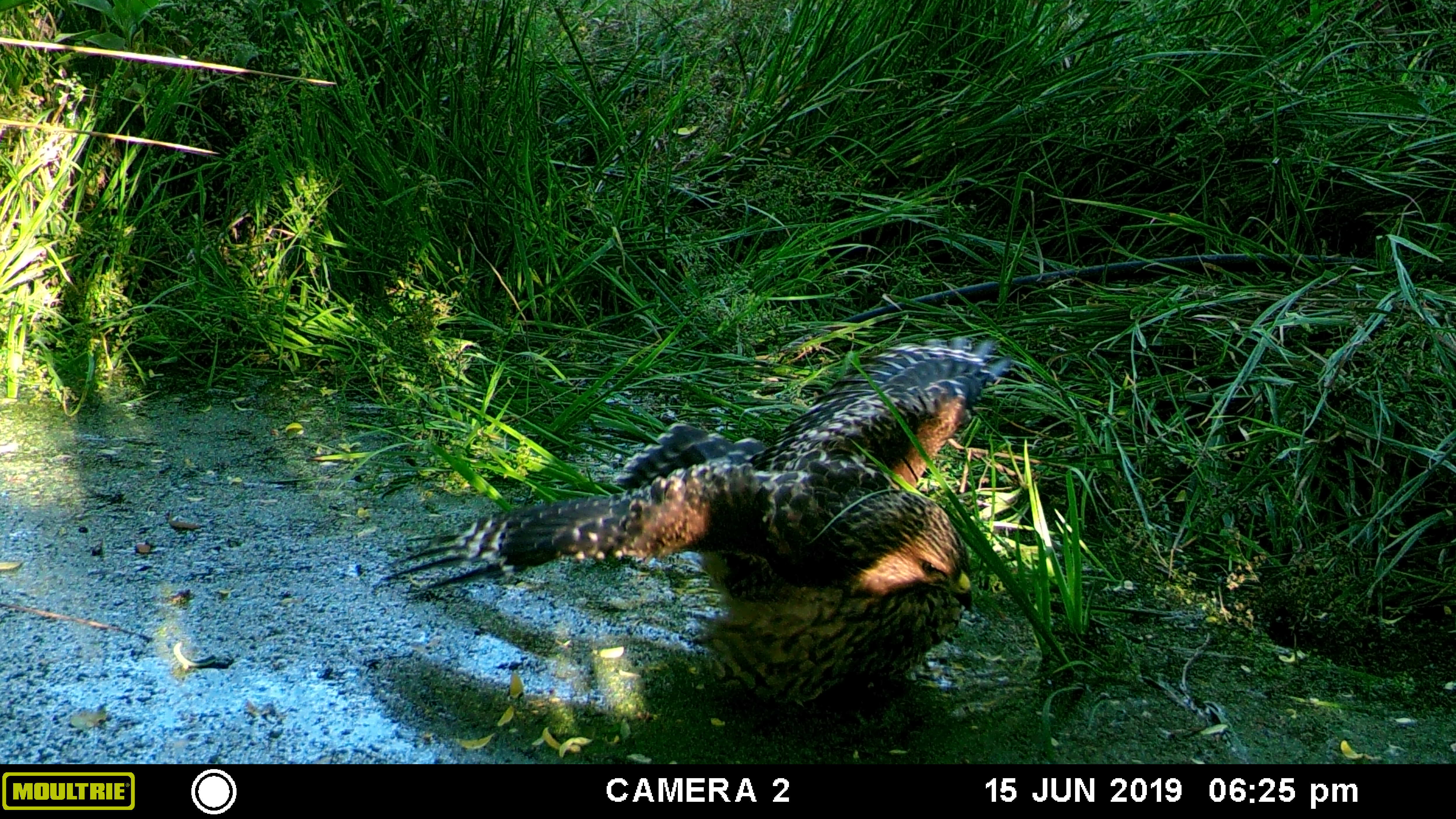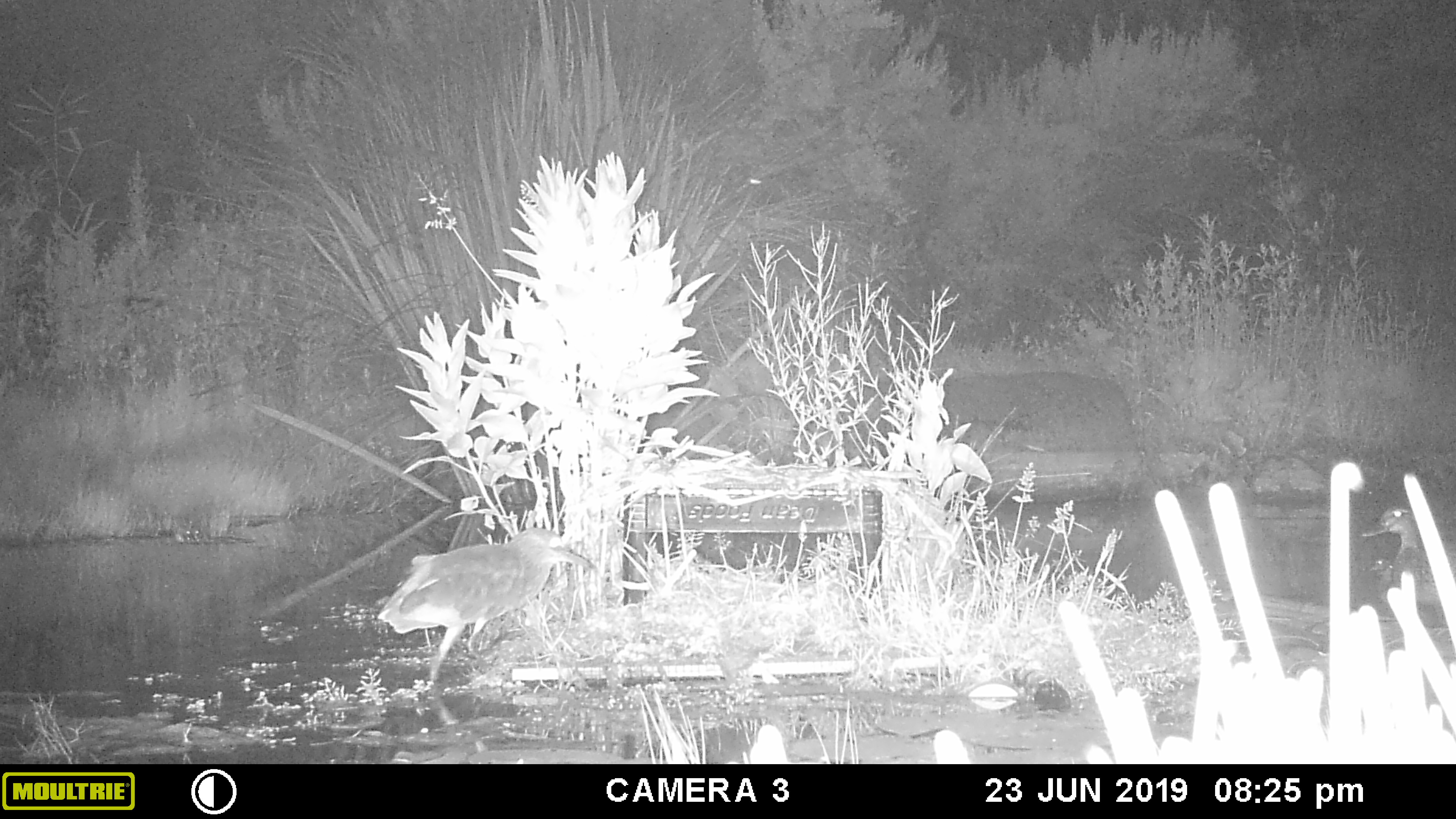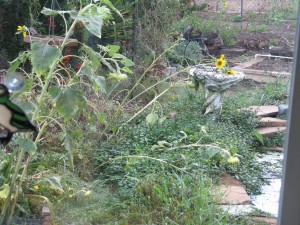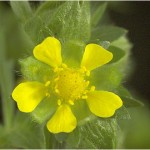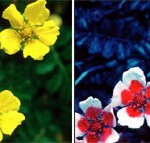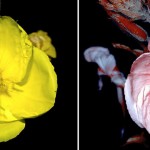-
Mrs. Two Sheds
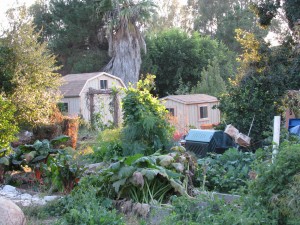
Two sheds seen through the veggie garden Since I had the other enormous and disintegrating sheds taken down last February, freeing up space and providing a lot of materials to recycle into other incarnations on the property, I have had no place to protect my tools. After much debate and shopping around I finally decided on Quality Sheds in Menifee. They build sheds right on the property in a day and cost far less than hiring a carpenter to do it. They offer a warranty on the materials as well.
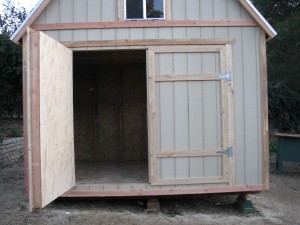
Tall Gambrel with double door In San Diego County you don’t need a building permit if the roof of the structure doesn’t exceed 120 square feet. I purchased a 10 x 12′ tall gambrel shed, with a loft and windows installed by popular window companies (more at Maverick Windows website), as well as a 6 x8′ potting and tool shed with a workbench. Not only did Quality sheds honor an outdated price sheet that I had, but gave me a discount for paying for two sheds and there was a 50% off sale on all ‘extras’ such as windows.
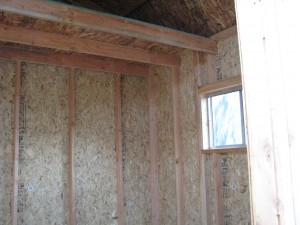
The loft I had these two sheds built for less than half of what a smaller area was bid me by a carpenter, and the large shed was $3,000 less than a bid for a smaller shed.
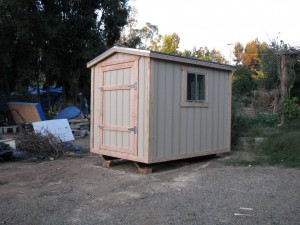
Potting Shed I still have to paint the sheds, and since the ground wasn’t level the sheds are propped up and to drive my mower in I’ll need to make a ramp.
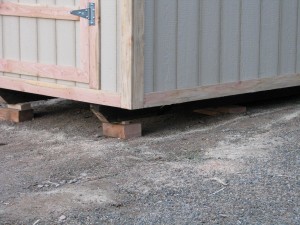
Up on blocks 
A little precarious But finally! Somewhere handy to store my tools and to putter around in.

Workbench in potting shed Neither shed blocks a view, and they look natural where they are. Although I wish that the ground had been leveled when I had asked when the tractor was here digging the pond, because I’ll have to replace the stacked wood props with cement blocks at some point.
Can’t wait to paint and finish the sheds!

Sheds reflecting in the pond… how poetic! - Bees, Birding, Gardening adventures, Heirloom Plants, Other Insects, Permaculture and Edible Forest Gardening Adventures, Photos
Bouquets for Birds and Butterflies

Lilliput zinnia At the beginning of this summer, the new subterranean drip irrigation system was installed on my property. It features tubing with holes at either twelve or twenty-four inches apart. When it runs (from my well) it leaves circles of dampness polka-dotting the soil surface. I had purchased two packets of wildflower seed, one with a selection of plants to attract bees, and the other for butterflies. Mixing them together, I figured that they wouldn’t fare well scattered, at least this year. My daughter and I pressed seed into many of the wet spots and hoped the rabbits wouldn’t notice.
What happened was a delightful surprise, as only a garden can provide. In many locations around the yard grew mixed bouquets of wildflowers.

Mexican sunflower, cosmos, nasturtiums, zinnias, surround a white calla lily If we had separated selected seed and planned the planting, nothing so beautiful would have come of it. Although many species either didn’t emerge or were eaten, the most common survivors were zinnias, cosmos and borage.

Cosmos, borage, zinnias and alyssum. I was amazed and thrilled; I had purchased a borage plant and then fed it to the rabbits (at least, that is what they thought). Here now are borage plants all over the yard, their royal blue, cucumber-flavored flowers dipping modestly behind the flaunting cosmos.
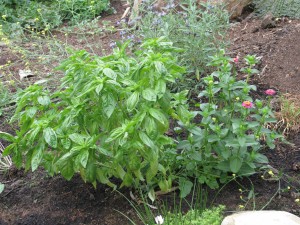
Sweet basil, cilantro, dill and zinnias In fact, I now have several very hearty sweet basil plants that put the carefully cultivated plants in my raised veggie beds to shame. There is also dill and cilantro growing well even this late in the season.

Cosmos, sweet basil, zinnias, borage, camellia balsam, alyssum There are some plants in the bouquets that haven’t reached maturity yet, so there may still be some surprises. The only flower that emerged that I didn’t recognize and had to look up was camellia balsam (Impatiens balsamina). Two stalks of it, one pink and one red, give these ‘arrangements’ a vertical line.
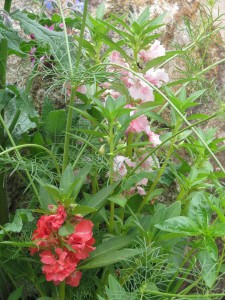
Camellia balsam (Impatiens balsamina) Although not all of these wildflowers are native to San Diego, or even California, they provide food for birds, bees and are host plants for butterflies, providing the caterpillars food, a place to form their chrysalises, and nectar for the mature butterfly. Bees like small flowers with little drops of nectar too small to drown in, with a nice landing pad of a petal close by. Everything in the carrot family works well. Here are some suggested flowers to plant:
For butterflies:
Mexican lupine, Mexican sunflower, borage, calendula, camellia balsam, scabiosa, cornflower, milkweed, parsley, crimson clover, aster, coreopsis, cosmos, prairie gayfeather, purple coneflower, sweet sultan, sneezeweed, sweet William, bishops flower, black-eyed Susan, dill, snapdragon, yarrow, bergamot, cleome, verbena, and butterfly bush.
For bees:
Cosmos, sunflowers, borage, coriander, Siberian wallflower, dill, coreopsis, poppies, gaillardia, zinnia, sweet basil, purple prairie clover, globe gillia, catnip, lemon mint, black-eyed Susan, goldenrod, lavender hyssop, bergamot, yarrow, mint, California buckwheat.
Be sure to plant flowers that bees love away from paths and walkways if you or your family want to avoid contact with the bees.
-
Oh, Whatta Night
-
First Rain
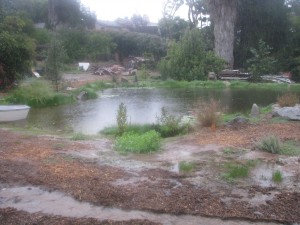
Rainfall on the pond The first week of October and we’re having a day of heavy rain… almost unbelievable. Normally October in San Diego is high fire season. The brush is crisp from months of drought and high temperatures, and then the Santa Ana winds begin: wild dry winds that blow east to west from the deserts, full of static and mad gusts that turn brush fires into firestorms.
My property is a watershed, funneling rainwater from the street through to the streambed in the barranca below, taking all my topsoil and some of the embankment with it. This year I had the beginnings of a permaculture garden installed to remedy this pattern. By deepening the loam and placing berms around plant guilds water is encouraged to pool up and soak in rather than run off. Overflow is channeled through a series of dry ponds which allow water to soak into the ground. From there it is channeled safely down to an overflow into the stream. Today was an early test of what has been worked on since Feb. 1.
The tilling, mulching and berming done by the crew of landscape architect Roger Boddaert proved successful.
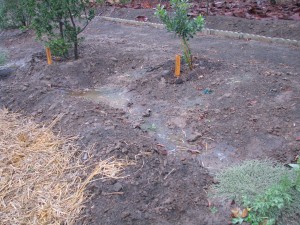
Berms hold water back so that it may soak into the loam The soil has a high clay content, which was good news when digging the large pond because it held water without a liner. It is bad news for other areas of the garden where water is pooling up instead of sinking in. I was able to take note of these areas this afternoon so that they could be drained and mulched for more absorption.
Aquascape, the company that installed the series of ponds, is still planting and maintaining the waterways. Jacob came out in the rain and watched it flow, shaping and fortifying as the force of the rain and thus the volume increased.
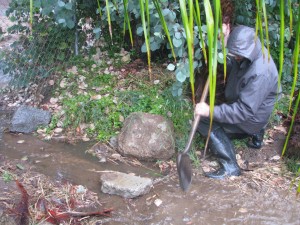
Jacob helping water flow Water flowed under the fence from the street, but instead of flooding a cement culvert as it used to do, it is channeled down to the ponds.
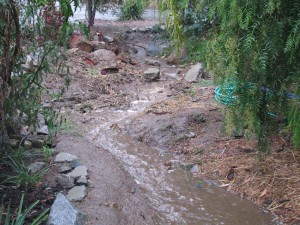
Street run-off enters under the fence 
Blocked by debris, water floods past the bridge Silt and debris blocked water flow under the bridge, and was eroding the area by the structure called the Nest. I cleared the debris and raked rocks and silt to the weak side, and that fixed the problem temporarily.
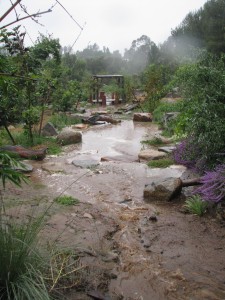
Rainwater flowing into the first 'dry' pond Water quickly filled the first dry pond; with the high clay content, water percolates but does it slowly.
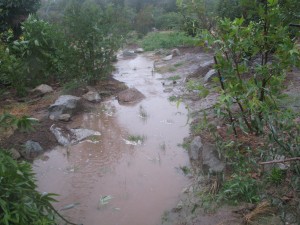
'Dry' ponds filling and slowing run-off 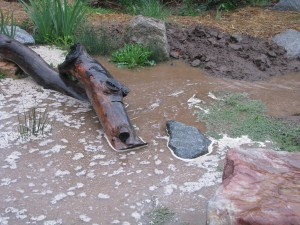
Logs and rocks are ornamental and slow water flow 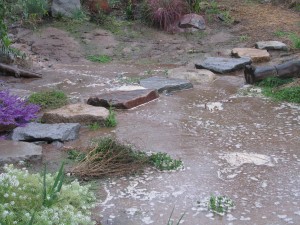
Normally dry, the stone crossing is now almost underwater 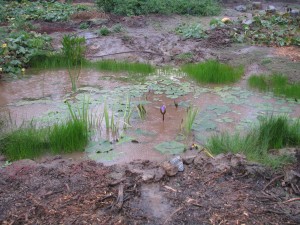
The little pond is rapidly filled. As water reached the small pond, which wasn’t intended to permanently hold water but the clay had a different idea, the sides had to be shored up and the overflow diverted.
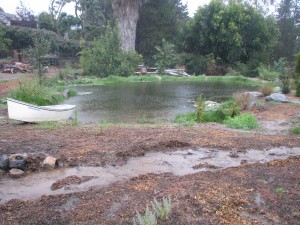
Water is diverted from the little pond around the big one Extra floodwaters aren’t being diverted into the large pond because we don’t want it filled with silt, and we don’t want it overflowing rapidly and eroding the sides. Instead the water flows through a channel around the large pond, then down to a prescribed place to flow out and over the embankment to the stream below.
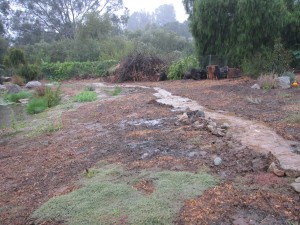
Overflow is channelled past the ponds and out to the natural stream below Some areas of heavy erosion had been filled and supported, and as of six this evening they looked wet but not iffy. What a night of heavy rain will do, I’ll have to see in the morning. I am very lucky to have this type of
rain early in the season. It has been heavy enough to cause significant water flow to help shape the watercourse and show weak spots, and the rain will be reduced to showers tomorrow then clear up, so repairs and improvements can be made before true flooding happens later in the year or early in the next.Although much more water is being held on the property, and topsoil is not being lost, it still pains me to see so much rain channeled out to the stream. Rainwater is a neutral Ph, and carries nitrogen (especially when
there is lightning). It is the best possible water for plants, as well as for human consumption and bathing. In side-by-side comparisons with tap water, plants watered with rainwater flourish far beyond the growth of the others. I’m greedy to hold that water onto my property, letting it soak as deeply as possible for tree roots to use far into the year. As the newly planted trees grow, their roots will help hold water and soil. As their leaves drop the mulch levels will raise, aided by compost and mulch that I will be constantly adding, and the soil will become more absorbent farther down. Each rain should have less runoff and more absorption. This rain has shown a great success with the garden, but I know it is only the beginning. -
St. Michael’s Mount

St. Michael's Mount Back to travel photos! While in Cornwall, we had to go to the coastal city of Penzance (because one of our favorite Gilbert and Sullivan plays is, of course, The Pirates of Penzance). From there we walked to the neighboring city of Marazion (don’t do this… drive!) to see St. Michael’s Mount http://www.stmichaelsmount.co.uk/ . From about 350 BC the Mount was a place where much trade took place, especially in local tin. Smuggling, too, I’m sure. Then in 495 AD some fishermen saw on the rocky island the vision of the angel St. Michael. Not long after a chapel was built and religious pilgrams flocked to the Mount.

An imposing structure A priory joined the chapel and the old, glorious castle appeared, jutting out of the hard stone and overlooking everything. Although a place of worship, many times in its history did the Mount have to take arms. Most notably it was from St. Michael’s Mount that the first beacon light was lit to warn of the Spanish Armada.
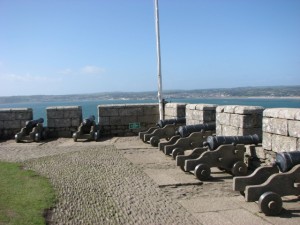
At some times the priory saw battle. After the Dissolution, it was purchased as the home of the St. Aubyn family, which it has remained ever since. In the 1950’s one of the family gave the structure into the hands of the National Trust, with the codicil that the family could live in it for 999 years. What makes St. Michael’s Mount very special is that it can be walked to across a causeway when the tide is low; when the tide covers the cobblestones, it becomes and island. We’d come to know about the causeway as it was used the in movie version of Shakspeare’s Twelfth Night.
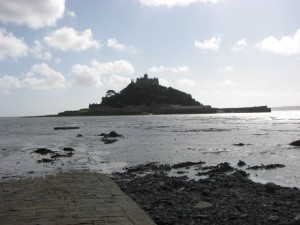
The causeway underwater We walked across the ankle-twisting cobbles to the imposing and ancient fortress.

A ruined gatehouse, with the causeway far below. We were still experiencing the very heavy winds from Hurricane Irene, so at times sand blew into our faces and it was a little hard to stand. Otherwise it was a clear and gorgeous day. Although still a private residence most of the castle can be toured.
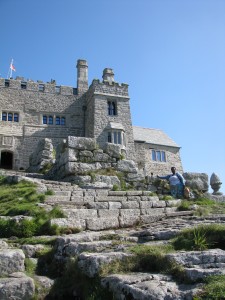
The 'front door' of the castle, facing west. 
Legend has it that a giant once lived on these giant stones. There is a grand library, and the place is rife with window nooks with the most incredible views of the English Channel.
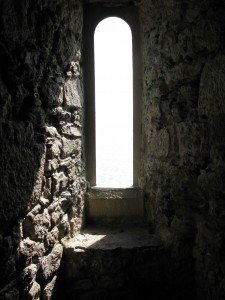
A stony window seat. The amount of labor that went into building these stone fortresses,
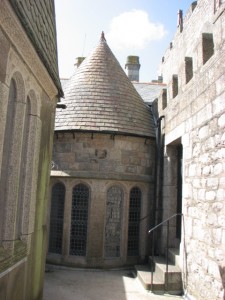
Beautiful and centuries-old workmanship. to make them last for centuries, always amazes me.

At the top of the priory The chapel boasts a rose window dated from the 15th century,

The Rose Window in the chapel as well as other fantastic artworks.
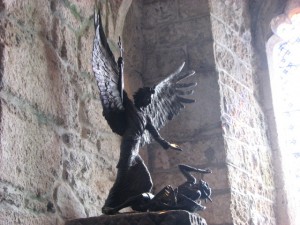
Artwork in the chapel In every room there are displays of beautiful handicraft,

Ornate sugar spoon and some unusual furniture.

An unusual chair Below the castle are sub-tropical gardens, which were closed the day we were there. We peered down at them and discovered… a good portion of the plants we have here in San Diego!

A view of a window nook, the gardens and the Channel. 
The sub-tropical gardens in temperate Cornwall When we were to leave, the water had just begun to cover the causeway. Some souls were crossing but getting their feet wet as the winds brought the tide in quickly. We waited for a boat ride and for only one pound fifty pence (!) each, we could achieve the mainland!
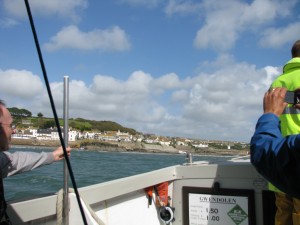
Heading back to shore. The water was choppy but we were with people who joked a lot, which we often found to be true in our British travels, and that made the crossing fun. There are festivals held on the Mount, along with re-enactments and garden tours. Check their website for announcements if you plan to visit, and keep an eye on the tides!
- Animals, Bees, Gardening adventures, Heirloom Plants, Other Insects, Permaculture and Edible Forest Gardening Adventures, Vegetables
What Bugs See
To veer off from the vacation photos, I thought I’d talk about bugs! I’ve been working in the garden a lot and watching the myriad types of insects drawn to the various flowers blooming all over, and it reminded me of something amazing that I learned last year. The way flowers look to us is not what most insects and birds see. The flowers are bright and showy, but they offer up visual clues to pollinators through colors and patterns that can only be seen with eyes that see UV light. Humans can’t. We can’t assign colors to UV light in the way that we understand them, so when photographing with UV light we substitute our colors to show the change in patterns. The markings on the flowers are guides to where the pollen is, like lights and painted lines on airport runways. Just as baby chicks’ mouths are large and brightly colored to show mom and dad where to put the worm, especially on the inside as they gape and wait to be fed, so have flowers made sure that the pollinators get to the right place for pollen! The differences between what we see and what insects see can be startling; there is a whole hidden world right before our eyes, just as there are supersonic and subsonic sounds that we cannot hear. Elephants make subsonic noises that other elephants can hear miles away, but we aren’t aware of it.
Below are photos taken with and without UV light by the brilliant Norwegian scientist-cameraman Bjorn Roslett. Remember that the UV colorization is man-made to show the difference in patterns. More technical information can be found at his site here: http://www.naturfotograf.com/UV_flowers_list.html , with lists of types of flowers and what approximate color changes there are under UV light.
Dandelion Vinca minor Vinca minor under UV Norsk mure (Potentilla norvegica) Norsk mure under UV Primrose Crocus Anemone
